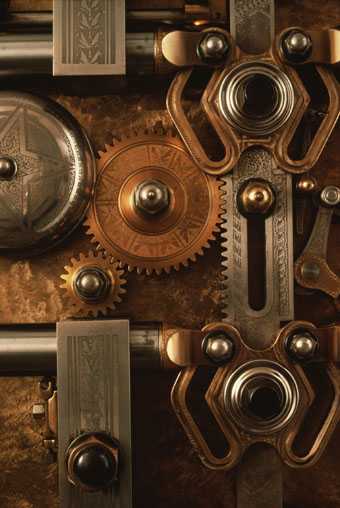What We Don't See at First
Today, some technologies we don't see when we first look. The University of Houston's College of Engineering presents this series about the machines that make our civilization run, and the people whose ingenuity created them.
A laser or a VCR is an invention that's right out in the open where we can see it. We admire such devices and their inventors. But have you ever thought how much ingenuity is hidden from view -- how much ingenuity we don't even realize is there?
For example, were you aware that gear teeth are far more than just wedges protruding from a wheel -- that their shapes have been mathematically formed so that smooth, almost-flat surfaces push against one another without any sliding? Gears are designed so the back of each tooth very nearly stays in contact with the mating tooth. That way the gear can be reversed without backlash. Some very complex human ingenuity has been used to avoid the sharp edges, sliding motion, and backlash that wear gears out.
Or consider the huge twelve-foot-long Swiss alpenhorn. I hadn't realized until a French horn player pointed it out, that it's the same instrument as the French horn you see in modern orchestras. Some ingenious musician realized it was possible to roll that length of tubing into a compact coil without losing tone.
It's unlikely that you know what a complex mathematical shape an ordinary highway curve is if you weren't trained as a civil engineer. Those curves are far from simple arcs of a circle. They're made from two pieces of Archimedean spirals. One piece starts out straight, goes to maximum curvature, then the second piece unwinds back to straight again. Highways are made that way because you can't to turn your steering wheel all at once, nor would you want to. Furthermore, the highway is banked from flat to a maximum angle and back to flat again. Like gear teeth, highway curves have very complex three-dimensional shapes.
The simple paper clip doesn't need much explaining on the face of it. We can all see how it works. But few of us have thought through the design problem that it solves. A paper clip must be easy to apply and remove. In fact, its use should be nearly self-evident. It shouldn't tear the paper. It shouldn't lose its grip with time or leave rust stains. It has to be very inexpensive.
Put all that together and you face a formidable design challenge. The paper clips that you and I use are a compromise solution which inventors still struggle to improve upon.
The examples go on. No one thought of those little yellow Post-It notes when a 3-M company engineer accidentally mixed up a batch of glue that refused to solidify. The stuff kicked around for months before another person saw what could be done with it.
We don't have to build the Brooklyn Bridge or invent the radio to change the world. The vast array of commonplace things that we handle every day summons up stunning displays of ingenuity. Anonymous genius rides all the anonymous parts of our anonymous machines, and it cries out the joyful "I am" of countless creative people.
I'm John Lienhard, at the University of Houston, where we're interested in the way inventive minds work.
(Theme music)
For the matter of highway design, see, e.g., Davis, R. E., and Foote, F. S., Surveying Theory and Practice (Third ed.). New York: McGraw-Hill Book Co., 1940, Sections 526 through 528, Spiral Curves.
Gear design is treated in any mechanical engineering design text. See, e.g., Shigley, J. E., and Uicker, J. J., Theory of Machines and Mechanisms. New York: McGraw-Hill Book Co., 1980, Chapter 7, Spur Gears.
Petroski, H., The Evolution of Artifacts. American Scientist, Vol. 80, September/October 1992, pp. 416-420. (for the history of the paper clip)
Nayak, P. R., and Ketteringham, J. M., Breakthroughs: How the Vision and Drive of Innovators in Sixteen Companies Created Commercial Breakthroughs that Swept the World. New York: Rawson Associates, 1986. Chapter 3 deals with the invention of Post-It notes.
This is a revised version of Episode 49.
